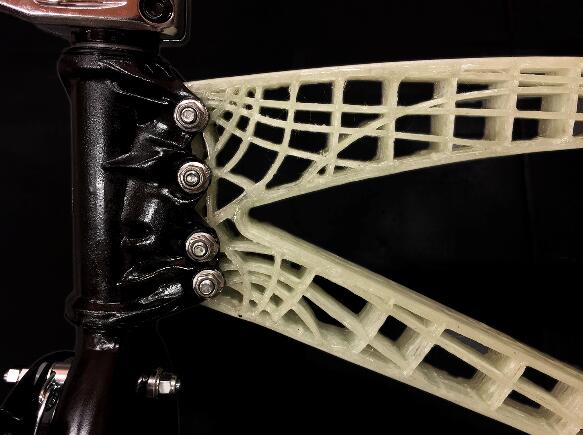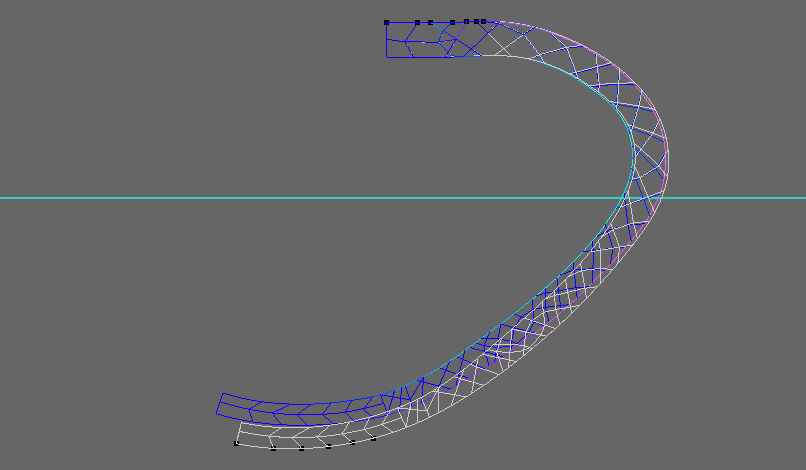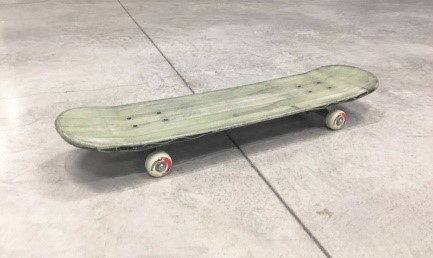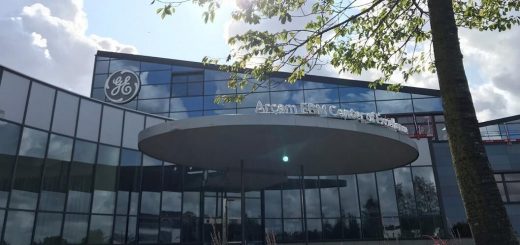Case Studies From Moi: The First CFM Frame for BMX
CFM, Continuous Fiber Manufacturing, is a potentially disruptive process that merges the performances of thermosetting composite materials with the potentialities of Additive Manufacturing.
The process was patented in 2015 inside “Politecnico di Milano” University, during the “Atropos” research program at +LAB, in the Chemistry, Materials and Chemical Engineering Department “Giulio Natta” – and in February 2018 the start-up “moi composites” is born, as the natural evolution of these academic results.
Moi’s technology Continuous Fiber Manufacturing (CFM) is capable of producing not only prototypes, but employable parts, which is very convenient for small series or tailor made objects.
Moi’s team has begun to collaborate with companies such as Owens Corning, KUKA, Autodesk, COMAU and ComoNeXT Innovation Hub. It’s from the work done alongside Autodesk that one of the most prominent features of the technology emerged: the optimization of fibers along the principal stress lines, which allows us to obtain the desired mechanical solution and reduce weight.
Moi also exploits the potentialities of Autodesk Netfabb Ultimate by fully integrating it at the base of its workflow, for computation and preparation of the 3D model.
The first outcome of the collaboration with Autodesk has been a BMX frame designed by moi and optimized to reduce its weight by 40%, from 3.0 kg to 1.8 kg, compared to the original steel frame. The bike has been 3d printed using continuous glass fiber composite material, maximizing all the potentialities offered by 6 axis robotic arm. In particular, in the back part of the frame, the fibers are not deposited in a parallel to plane manner, layer by layer, therefore achieving the best structural solution to exploit the anisotropy of material.

The BMX bike has been printed in three parts and then assembled using topological optimized 3D printed metal parts.
The bike has been designed using a voxel-based optimization algorithm that allows the generation of the desired building solution from given forces and constraints. This software is able to understand the theoretical distribution of stresses, distinguishing tension forces and compression forces, and design according to the most structurally efficient way.

Thanks to dedicated algorithms, it is also possible to reduce the interruptions of the fiber, optimizing the toolpath to better distribute the load.
For example, it is possible to enclose holes without interrupting the fibers, therefore making them work in tension. The frame has been realized in 3 parts and then assembled using topological optimized 3D printed metal connections.
Detail of the connection between the frame and the front fork. The holes for screws are described by the intersection of multiple lines rather than from a drilled hole, strenghtening the structure.
![]() SUPERIOR. The new CFM lower-limb running prosthesis
SUPERIOR. The new CFM lower-limb running prosthesis
Another example of CFM technology’s potential is “Superior”, a lower limb running prosthesis made with moi during thesis work at +LAB with the aim of exploiting the potential of the fiber optimization algorithm.
The algorithm has been used to obtain a desired elastic behavior, typical of running prosthesis, and specific to the athlete’s requests, that differ one from another, while reinforcing the device in its most stressed parts. The final design has been modeled and tested in FEA software proving its resistance with a maximum load of 150 kg.

This case also showed the possibility to combine traditional manufacturing with moi’s digital technology, using the glass fiber optimized 3D printed core, in order to remove the expansive cost of the mold and realizing structurally efficient internal geometries, and finished with carbon fibers plies laminated using the traditional vacuum technique.
It is possible to obtain different elastic behaviors by modifying the position and orientation of fibers to best suit the athlete’s demands.
![]() THE CFM SKATEBOARD
THE CFM SKATEBOARD
The same process has been applied to a skateboard, allowing it to flex in its central part and be rigid where the trucks are collocated.
Cavities for the screws have also been predicted and a reinforcement has been designed accordingly to the higher stresses.

The skateboard has been showcased and used during the Technology Hub and Plast exhibitions and is another example of a personal, on demand, high-performance part that moi’s technology is able to produce.

Different layouts of the fibers correspond to different elastic behaviors of the structure. The central part is more elastic while the connections with trucks are reinforced.
![]() MOI ONGOING EVOLUTION
MOI ONGOING EVOLUTION
Moi’s technology is always in development but its quality and stability has much improved, as well as its ability to print complex shapes without errors; in both of the last two presented objects, the prosthesis and the skateboard were printed overnight by the robot in total autonomy.
The robot has also been equipped with sensors for real-time feedback and modulation of the printing parameters for the best printing result, combined with property algorithms and adjusted software for robot control and relying on one of the best slicing software from Autodesk.
The universality and the scalability of the process has been proven by adopting a second, larger, robotic system, thanks to the collaboration with COMAU, with which the skateboard has been easily 3D printed. In fact, the new robotic cell is able to realize objects as large as 0.8m x 1m x 1.2m and new ones will go even bigger.
Moreover, the printing quality and precision have also been improved, allowing us to overcome the current size limitations of the machines by realizing mechanical joints with recesses while maintaining the external surface flushed. This allows the post-processing of the parts with other manufacturing techniques, e.g. traditional lamination, after all the pieces are mounted together.
As of today, moi’s technology is tested and stable using “Owens Corning” glass fibers and photocurable resins, and all the obtained composites have shown mechanical behaviors consistent with predicted calculations.
Moi is also studying the application of carbon and aramid fibers in the process while they are working on improving the overall quality of the process and of the produced objects, with new tool-heads and equipment, by enhancing the speed, optimizing the algorithms, and adding more sensors for security and live-control while starting to produce the first parts for clients in sectors such as Aerospace, Automotive, Biomedical, Nautical, Oil and Gas, Sports and Tooling.
Source: Autodesk




Recent Comments